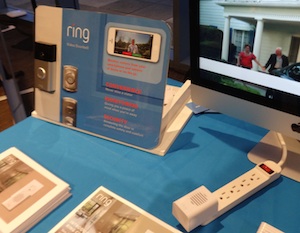
Not much new.
Ring – the company formally known as DoorBot – is still keeping it simple and growing slowly. It produces a camera with a motion sensor that attaches to your front door and lets you see who’s there – whether you’re at home or justing looking in from somewhere out on the interwebs via Ring’s Android or iOS app, or a browser. For a fee – $3 per month or $30 for an entire year – it’ll also store six months worth of high definition video.
The latest twist on the product was demoed at Pepcom’s Mobile Focus event in San Francisco last month: a remote doorbell. You plug a second gizmo into a wall socket inside your house, and when someone presses the doorbell button on the camera, it, well, rings. Why not just rely on the doorbell that comes with your house? If your house is like mine, the doorbell rings in the kitchen downstairs, and it’s easy to miss if you’re doing something upstairs. But guess what: that’s not a new problem and doorbell extenders and repeaters are not new products.
So far, Ring has only shipped 48,000 units in the couple of years its been in the market. The challenge for this kind of one trick pony home automation play is to stay relevant as multifunctions systems – think Google’s Nest or Lowes’ Iris – mature and begin to enter the mainstream consumer electronics consciousness. Ring has a roadmap that includes integration with networked door locks like Kevo, but it needs to move faster if it wants to stay in the game.
